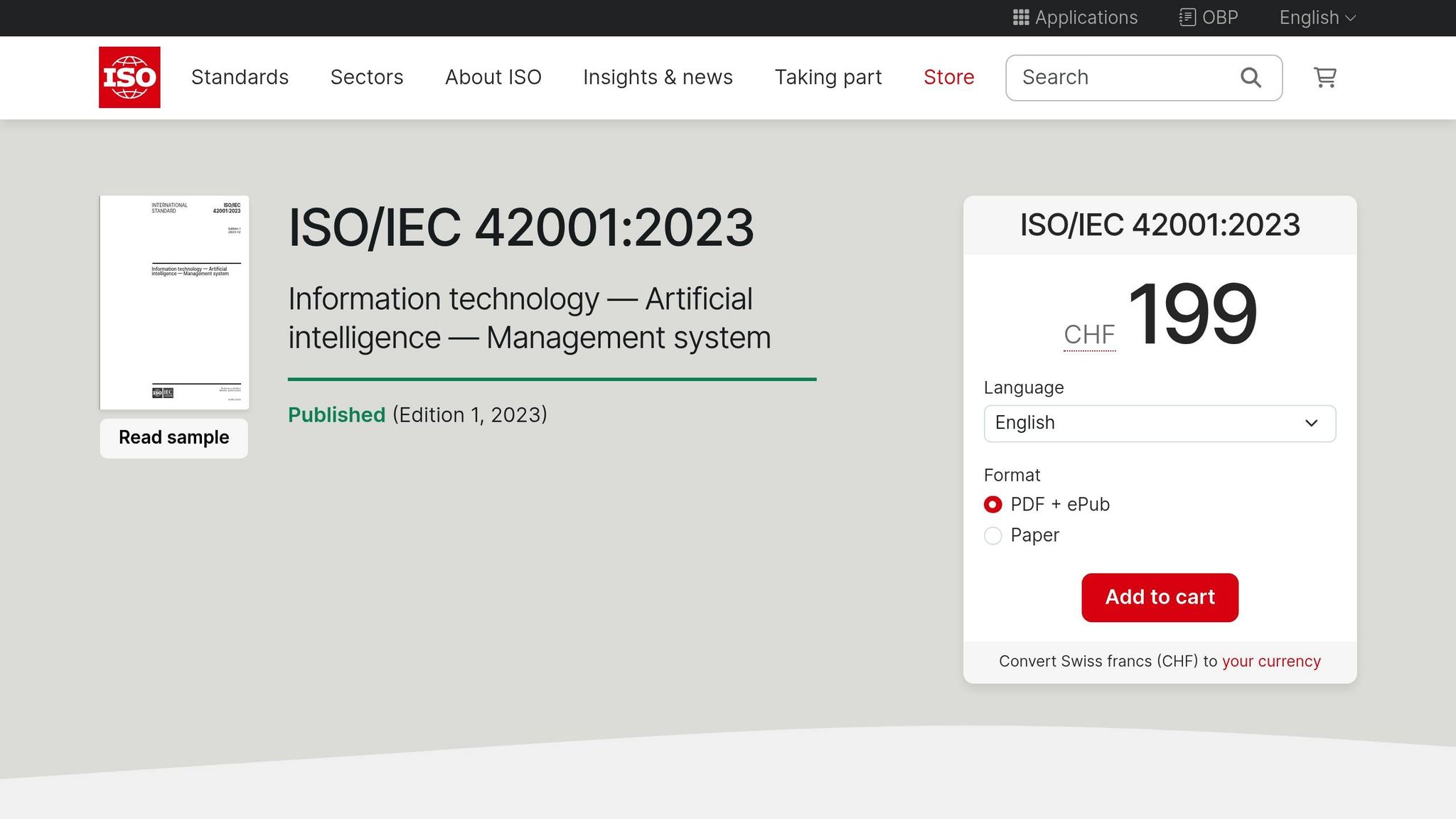Designing AI for Transparency and Accountability
Explore essential principles for creating transparent and accountable AI systems that build trust and comply with regulations.

Artificial Intelligence (AI) systems are transforming industries, but ensuring their transparency and accountability is critical. Transparency means making AI decisions understandable, while accountability ensures someone is responsible for those decisions. Without these pillars, businesses risk losing trust, facing legal challenges, and failing to meet regulatory standards.
Key takeaways:
- Transparency: Use explainable AI (XAI), clear documentation, and traceable workflows to make AI decisions understandable.
- Accountability: Assign responsibility, conduct audits, and maintain human oversight to manage AI outcomes effectively.
- Data Protection: Secure sensitive data, prevent bias, and comply with privacy laws like the CCPA.
AI Transparency, Explainability, and Accountability (ISO 42001)

Core Principles of Transparent and Accountable AI Systems
Creating transparent and accountable AI systems revolves around principles that ensure clarity, fairness, and compliance with regulations. These principles provide actionable steps to make AI systems understandable and responsible.
Transparency: Making AI Decisions Clear
Transparency means helping stakeholders understand how AI systems work - how they reason, what data they use, and the processes behind their decisions.
Techniques like explainable AI (XAI) break down complex algorithms into digestible parts. Instead of treating AI as an enigmatic "black box", XAI reveals not just the decision but the reasoning behind it. For example, in a loan application scenario, the AI should explain how factors like credit history, income stability, or debt-to-income ratio influenced the decision.
To make this information accessible, intuitive interfaces are key. Overly technical explanations filled with jargon won’t help most users. Instead, clear summaries, visuals like charts, and plain language explanations can make AI decisions easier to grasp.
Traceability also plays a critical role in transparency. This involves documenting the data, algorithm version, and reasoning behind each decision. If questions arise - whether from customers, regulators, or internal teams - organizations need the ability to retrace and justify the AI’s steps.
While transparency ensures clarity, accountability focuses on assigning responsibility.
Accountability: Assigning Responsibility for AI Actions
Accountability is about defining who is responsible for AI outcomes. Unlike transparency, which explains the "how", accountability answers the "who" - who is answerable for the system's results, whether positive or negative.
To achieve this, clear ownership structures are necessary. This involves assigning specific individuals or teams to oversee areas like data quality, model performance, user impact, and regulatory compliance. Organizations might appoint AI ethics officers, establish cross-functional oversight committees, and set up clear escalation paths for addressing concerns.
Regular audits are another cornerstone of accountability. These audits evaluate everything from data accuracy and model performance to unintended biases and outcomes. Ideally, these reviews are conducted by experts with the authority to identify problems and suggest improvements.
Human oversight is also essential. While not every AI decision requires review, human involvement should focus on significant decision points. For high-stakes scenarios - like medical diagnoses or financial approvals - experts should have the ability to review, override, or adjust AI recommendations as needed.
Data Protection, Privacy, and Security
Transparency and accountability are bolstered by strong data protection practices. Since AI systems often handle sensitive information, safeguarding this data is critical to maintaining trust and meeting legal standards.
Privacy protection involves limiting data collection to what’s necessary, ensuring secure storage and transmission, and giving users control over their personal information. U.S. laws, for instance, grant users the right to access, correct, and delete their data.
AI systems must also treat all users fairly. This means identifying and addressing biases in training data, algorithms, and outcomes. Testing should assess whether different demographic groups experience unequal results, and corrective actions should be taken if disparities are found.
Security measures are equally vital. Protecting AI systems from cyberattacks, data breaches, and unauthorized access is non-negotiable. This includes securing infrastructure, implementing access controls, monitoring for threats, and having incident response plans in place. For many AI applications, security is not just a best practice - it’s a legal obligation.
Strategies for Implementing AI Transparency
Creating transparent AI systems involves intentional design and practical strategies. The following approaches aim to make AI systems easier to understand, build trust with users, and meet regulatory expectations.
Explainable AI (XAI) Techniques
Explainable AI (XAI) focuses on making complex algorithms easier to understand by clarifying how decisions are made. One popular method is feature attribution, which highlights the key factors influencing a decision and ranks them by importance. For example, in credit scoring, feature attribution might show how payment history or income impacts the final decision.
Using simpler models can also improve clarity. Decision trees, for instance, break decisions into straightforward if-then rules, while linear models reveal direct relationships between inputs and outputs - making the decision-making process more transparent.
Visual tools further bridge the gap between complex models and non-technical users. For example:
- Heat maps can pinpoint areas of an image that influenced a medical diagnosis.
- Bar charts can illustrate which factors weighed most heavily in a loan approval.
- Interactive dashboards allow users to experiment with inputs and see how outcomes change.
Another valuable XAI tool is counterfactual explanations, which answer the question: "What would need to change for a different outcome?" For instance, if someone is denied a loan, a counterfactual explanation might show that improving their credit score or reducing their debt could lead to approval. This approach not only explains the decision but also provides actionable insights.
These techniques support transparency by making AI decisions clearer, traceable, and easier to document.
Documenting and Communicating AI Decisions
Clear documentation is essential for translating complex AI processes into understandable information for a variety of audiences. This involves tailoring explanations to suit different needs.
For users, explanations should avoid technical jargon and use plain language. Instead of saying, "The neural network's confidence score was 0.87 based on feature weights", you could say, "We’re confident in this recommendation because it closely matches your previous preferences." Adding visuals like progress bars or charts can also make the information more digestible.
For technical teams, auditors, and compliance professionals, detailed documentation is key. This should include:
- Model architecture and training data details
- Performance metrics and known limitations
- Version histories to track updates and changes
Decision logs are another vital tool. These logs record input data, decisions made, confidence levels, and the explanations provided to users. Searchable and timestamped, they become invaluable during audits or when addressing concerns.
Using diverse communication formats ensures that everyone - from executives to customer support teams - gets the information they need. For instance:
- Executive summaries offer high-level insights for leadership.
- Detailed reports help with compliance and auditing.
- Interactive demos can assist sales teams.
- User guides support customer service in addressing questions.
By making AI decisions accessible and understandable, documentation strengthens transparency and trust.
Traceability and Auditability
Building on clear documentation, traceability ensures accountability by creating a detailed record of how decisions are made. This is crucial for meeting regulatory requirements and maintaining stakeholder confidence.
Data lineage tracking documents every step of the data’s journey - from its original source to preprocessing, feature engineering, and its role in model training. This allows teams to verify data accuracy and pinpoint where issues may have arisen.
Model versioning keeps a detailed history of algorithm updates, including deployment dates, performance metrics, and descriptions of changes. If questions arise, teams can trace back to specific versions to identify potential problems.
Audit trails provide a comprehensive log of system activity. They record who accessed data, when models were retrained, and what configuration changes were made. These tamper-proof logs are essential for demonstrating responsible AI practices and ensuring compliance.
Reproducibility frameworks ensure that AI decisions can be recreated consistently. This involves preserving not just the final model but also the entire training environment, preprocessing steps, and hyperparameters. With this level of detail, internal teams and regulators can verify that the AI behaves as expected.
Finally, automated monitoring plays a critical role in maintaining trust. By continuously tracking system behavior, automated tools can detect unusual patterns like data drift, performance drops, or emerging biases. Alerts allow teams to quickly investigate and address these issues.
Together, these traceability measures create a strong foundation for accountability, making it easier for organizations to explain decisions, meet regulations, and resolve problems effectively.
Organizations looking to implement these transparency strategies can benefit from expert assistance. NAITIVE AI Consulting Agency (https://naitive.cloud) specializes in designing and managing AI solutions that prioritize transparency and accountability, ensuring compliance with regulations while meeting stakeholder expectations.
Accountability Frameworks and Tools
Accountability in AI isn't just about saying the right things - it's about putting real systems in place to ensure oversight and responsibility. In the U.S., where businesses operate within a complex regulatory landscape, having structured frameworks and practical tools is essential to keep AI systems in check.
Ethics Boards and Accountability Structures
Accountability starts with clearly defining who makes decisions and who takes responsibility for AI outcomes. Ethics boards play a central role here, bringing together experts with insights into technology, law, and business to guide AI development responsibly.
An effective ethics board typically includes technical professionals, legal experts knowledgeable about U.S. regulations like the Americans with Disabilities Act or the Fair Credit Reporting Act, business leaders, and external advisors who represent impacted communities or industries. Crucially, these boards need actual decision-making power - not just an advisory role.
To further clarify roles, organizations often use role-based accountability matrices. For example:
- AI product managers oversee user experience and ethical considerations.
- Data scientists ensure the accuracy of models and address bias.
- Legal teams handle compliance with regulations.
- Executive sponsors take responsibility for high-stakes deployment decisions.
This level of clarity prevents confusion and ensures everyone knows their part in the process.
Escalation pathways are another critical tool. They outline what happens when something goes wrong. For instance, customer service teams might flag unusual AI behavior to technical teams, who then decide if the issue needs to go to the ethics board. Specific triggers - like detecting bias above a certain threshold or receiving a spike in user complaints - can automatically escalate issues.
Finally, decision-making protocols ensure that high-stakes AI decisions are handled with care. For example, some companies require ethics board approval before using AI in areas like hiring, lending, or healthcare. Others mandate impact assessments before launching new AI systems or making major updates to existing ones.
Building on these structures, regular auditing ensures accountability remains an ongoing effort.
Regular Auditing and Impact Assessments
Accountability doesn't stop at setting up frameworks - it requires constant checks to ensure AI systems are working as intended and staying aligned with company values. This is where audits and assessments come in.
Algorithmic audits systematically review AI behavior, looking for issues like bias, inaccuracies, or unintended consequences across different scenarios and user groups.
Performance audits focus on whether AI systems meet their goals without causing harm. For example, a hiring algorithm might be audited to confirm it identifies qualified candidates while avoiding discrimination against protected groups. These audits often reveal subtle problems that emerge over time as data patterns shift.
Bias assessments take a closer look at fairness. They test AI performance across various demographic groups, regions, or other relevant categories. For instance, a loan approval system might work well for urban applicants but show bias against rural ones, prompting adjustments to the model.
Impact assessments examine the broader effects of AI on stakeholders, communities, and business operations. These assessments help organizations understand both the intended and unintended consequences of their AI systems.
To add an extra layer of scrutiny, third-party audits bring in outside experts to review AI systems. Independent auditors can catch issues internal teams might overlook and provide credibility for regulators, customers, and other stakeholders. Many businesses conduct these audits annually or before major system updates.
Finally, compliance monitoring ensures AI systems stay within legal boundaries as regulations evolve. Automated tools can track changes in laws and industry standards, flagging any potential risks when system behavior starts to deviate.
When audits uncover potential issues, human oversight becomes critical for maintaining control.
Human-in-the-Loop Oversight
Even the most advanced AI systems benefit from human oversight, especially when decisions carry significant consequences. Human-in-the-loop approaches combine human judgment with AI capabilities, ensuring accountability without sacrificing efficiency.
Organizations often set review thresholds to flag cases for human evaluation. For example, loan applications might require human review if the AI's confidence level falls below 80% or if an applicant's profile doesn't fit typical patterns. Similarly, medical AI systems often rely on physicians to review ambiguous diagnoses.
Sampling strategies allow human reviewers to examine a portion of AI decisions, even when reviewing every single case isn't practical. Random sampling can catch general issues, while targeted sampling focuses on high-risk cases or areas with known problems. Some companies might randomly review 5% of decisions while thoroughly examining 100% of high-risk cases.
To ensure humans can step in when needed, override mechanisms allow them to reverse AI decisions in specific situations. Patterns in these overrides can highlight broader issues, such as gaps in training data or limitations in the AI model.
Feedback loops are another way human insights improve AI systems over time. When reviewers correct AI decisions, their input can feed back into the system, refining training data and decision rules. This creates a cycle of continuous improvement.
Finally, quality assurance processes ensure human oversight remains effective. This includes training reviewers to understand AI capabilities and limitations, measuring consistency among reviewers, and monitoring their performance over time. Regular calibration keeps oversight reliable and aligned with organizational standards.
Together, these frameworks and tools provide multiple layers of oversight, catching problems early and ensuring AI systems are deployed responsibly. They don't just protect organizations from risks - they also build trust with stakeholders and reinforce compliance with regulations, turning accountability into a practical, actionable process.
Best Practices for Human-Centered AI Design
User feedback plays a crucial role in shaping AI systems, offering insights that refine performance and improve user experiences. Let’s explore how incorporating feedback can drive continuous improvements in AI design.
Using User Feedback
Feedback from users is the backbone of improving AI systems and fostering trust. To make this process effective, organizations should integrate feedback mechanisms directly into the user experience, ensuring they are easy to use and non-intrusive.
"Every interaction trains the AI, refines outputs, and enhances accuracy while allowing personalized experiences and trust".
These feedback tools give users the ability to tailor their interactions with the system, helping it evolve to better meet their needs over time. This dynamic relationship ensures that AI technology stays relevant, responsive, and aligned with user expectations.
Governance, Compliance, and Ongoing Improvement
Creating AI systems that are ethical, accountable, and effective demands a strong focus on governance, compliance, and continuous improvement. These pillars work together to ensure AI systems operate responsibly throughout their lifecycle.
AI Governance Models
Strong governance begins with clear and accountable structures to oversee AI development and deployment. Cross-functional governance committees are essential, bringing together experts from technical, legal, ethical, and business domains. These committees often include representatives from engineering, compliance, risk management, and business units to provide well-rounded oversight.
Organizations can adopt different governance models depending on their needs:
- Centralized governance models are ideal for organizations with standardized AI applications across departments. In this setup, a central AI office or committee creates policies, sets standards, and establishes approval processes for all teams. While this approach ensures consistency, it requires strong leadership and effective communication to avoid delays or bottlenecks.
- Federated governance models give individual business units more autonomy while maintaining central oversight for high-risk applications. Departments manage their own AI projects within established guidelines, escalating complex or high-impact decisions to a central governing body. This approach strikes a balance between agility and control, allowing teams to act quickly while staying accountable.
The best governance structures clearly define roles, responsibilities, and escalation paths for ethical concerns and technical challenges. They also set approval thresholds based on risk levels and conduct regular reviews to evaluate performance and impact.
Once governance structures are in place, organizations must turn their attention to navigating the complex and ever-changing U.S. regulatory landscape.
Regulatory Compliance in the U.S.
AI systems must operate within a maze of federal and state regulations that are constantly evolving. At the core of AI compliance are data privacy laws, such as the California Consumer Privacy Act (CCPA), which require organizations to disclose how they collect, use, and share personal data in AI systems.
Different industries face additional regulatory requirements:
- Financial services must adhere to the Fair Credit Reporting Act (FCRA) and the Equal Credit Opportunity Act (ECOA). These laws demand transparency and fairness in automated decision-making, requiring institutions to explain AI-driven credit decisions and ensure their systems do not discriminate against protected groups.
- Healthcare AI must comply with HIPAA to protect patient data and meet FDA guidelines for AI-powered medical devices. These regulations require detailed documentation of development, testing, and validation processes.
- Employment-related AI systems are subject to Equal Employment Opportunity Commission (EEOC) guidelines, which mandate that AI tools used in hiring or promotion processes do not result in discrimination. Regular bias testing and thorough documentation of decision-making processes are critical.
State-level regulations add further complexity. For example, New York City’s Local Law 144 requires employers to conduct annual bias audits of automated employment decision tools. Other jurisdictions are introducing similar requirements to promote AI transparency and accountability.
Given the dynamic nature of these regulations, organizations must continuously monitor changes to ensure compliance.
Regular Monitoring and Updates
Maintaining AI systems that are transparent and accountable requires constant attention through systematic monitoring and updates. Performance monitoring involves tracking key metrics like accuracy, fairness, and user satisfaction. Organizations establish baseline measurements during deployment and set thresholds that, if exceeded, trigger further investigation.
Bias assessments are conducted regularly, with many organizations performing quarterly reviews or even more frequent checks for high-risk applications. If issues are detected, retraining the model becomes necessary.
The frequency of model retraining depends on the application and data environment. Systems handling rapidly changing data may need monthly updates, while others with more stable data might follow quarterly or yearly cycles. Regular retraining helps maintain performance while managing costs.
Documentation is another critical piece. Updates must be recorded and shared with stakeholders through tools like model cards, decision logs, and user-facing explanations. Version control systems track changes over time, making it easier to understand how updates impact system behavior and outcomes.
Stakeholder reviews are also vital. These sessions bring together technical teams, business users, and affected communities to evaluate system performance and address concerns. Both quantitative metrics and qualitative feedback are considered to identify areas for improvement.
Conclusion: Building Trustworthy AI with Transparency and Accountability
Creating AI systems that people can trust demands a strong focus on transparency and accountability at every stage of development. These two principles serve as the foundation for building reliable and ethical AI.
Transparency involves making AI's decision-making processes understandable through explainable methods, thorough documentation, and traceable workflows. This is especially critical in areas like healthcare and hiring, where AI decisions can have a profound impact on people's lives.
Accountability ensures that responsibility for AI-driven decisions is clear and actionable. This can be achieved through governance structures, regular audits, and human oversight, blending the speed and efficiency of AI with ethical judgment and human reasoning. Together, these principles help organizations stay compliant as regulatory landscapes continue to evolve.
With laws like the CCPA shaping how data is handled and industry regulations becoming stricter, staying ahead of compliance requirements is more important than ever. Businesses must balance these demands while maintaining operational efficiency.
Building trustworthy AI is not a one-and-done process - it’s an ongoing effort. Regular monitoring, bias evaluations, and feedback from stakeholders help ensure AI systems remain ethical, effective, and aligned with organizational goals. Companies that adopt this mindset of continuous improvement will be better equipped to harness AI's transformative capabilities while managing its risks.
For organizations seeking expert guidance in applying these principles, NAITIVE AI Consulting Agency offers tailored, compliant AI solutions. Their expertise in building autonomous AI systems and automating business processes is rooted in a commitment to transparency and accountability. By prioritizing these values from the outset, NAITIVE delivers AI implementations that are both powerful and responsible, helping businesses achieve measurable results without compromising ethics.
FAQs
What steps can organizations take to keep their AI systems transparent and accountable over time?
Organizations can uphold transparency and accountability in AI systems by keeping detailed documentation that tracks changes in algorithms and data. This ensures a clear trail of adjustments and decisions. Additionally, setting up structured governance frameworks and performing regular audits helps maintain ethical standards and compliance.
Open communication with stakeholders is another crucial step. By sharing periodic transparency reports, organizations can foster trust and demonstrate accountability. Ongoing monitoring, timely updates, and a strong dedication to ethical guidelines are essential for keeping pace with the ever-evolving landscape of AI systems while staying transparent.
Why are ethics boards and accountability structures important for managing AI systems responsibly?
Ethics boards and accountability frameworks are essential for guiding the responsible development and use of AI systems. They set ethical standards, encourage transparency, and work to reduce risks like bias or improper use.
These frameworks also play a key role in oversight by tracking compliance, performing audits, and assigning responsibility for the outcomes of AI systems. By ensuring individuals or organizations are held accountable, they help build trust and keep AI technologies in line with societal values and what users expect.
Why are regular audits and human oversight essential for ethical AI deployment?
Regular audits and human oversight are essential for keeping AI systems aligned with ethical and responsible practices. Audits act as a checkpoint, assessing these systems against important principles like fairness, transparency, and accountability. They help uncover biases or flaws that might affect how the AI performs or makes decisions.
Human oversight, often called human-in-the-loop, brings human judgment into the equation, especially in sensitive or high-stakes scenarios. This approach ensures that AI-driven actions stay in line with human values, ethical guidelines, and societal norms. By combining these efforts, we can build trust, encourage accountability, and minimize the risks tied to AI technologies.




